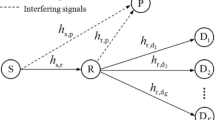Abstract
In this paper, we investigate outage performance of dual-hop cognitive AF relay networks with multiple primary users (PUs) and heterogeneous non-identical parameters, including non-identical Rayleigh fading channels, non-identical interference power constraints of PUs, and non-identical noise powers in signals. To overcome the analysis complexity resulted from the consideration of heterogeneous non-identical parameters completely, we conduct our analysis in two steps. In the first step, we focus on networks with non-identical Rayleigh fading channels but with identical interference power constraints and identical noise powers. As analysis results, both the exact closed-form expression and asymptotic closed-form expression of the cumulative distribution function of equivalent end-to-end signal-to-noise ratio of the network are obtained. Then in the second step, we propose a method for transforming networks with heterogeneous non-identical parameters into new networks with identical interference power constraints and identical noise powers meanwhile guaranteeing that outage performance of the two networks before and after the transformation are identical. Hence, outage performance of networks with heterogeneous non-identical parameters can be obtained by applying the analysis results in the fist step to the corresponding transformed networks. Numerical simulations validate the correctness of our analysis, and the simulations also indicate that taking multiple PUs and the diversity of the parameters into consideration is of key importance in obtaining a more accurate estimation of outage performance of such networks.




Similar content being viewed by others
References
Marinho, J. M., & Monteiro, E. (2012). Cognitive radio: Survey on communication protocols, spectrum decision issues, and future research directions. Wireless Networks, 18(2), 147–164.
Hong, J. P., Bi, H., Ban, T. W., et al. (2012). On the cooperative diversity gain in underlay cognitive radio systems. IEEE Transactions on Communications, 60(1), 209–219.
Duong, T. Q., Costa, D. B. D., Elkashlan, M., & Bao, V. N. Q. (2012). Cognitive amplify-and-forward relay networks over Nakagami-m fading. IEEE Transactions on Vehicular Technology, 61(5), 2368–2374.
Xia, M. H., & Aïssa, S. (2012). Cooperative AF relaying in spectrum-sharing systems: Performance analysis under average interference power Constraints and Nakagami-m fading. IEEE Transactions on Communications, 60(6), 1523–1533.
Sklar, B. (1997). Rayleigh fading channels in mobile digital communication systems part I: Characterization. IEEE Communications Magazine, 35(7), 90–100.
Abdi, A., Tepedelenlioglu, C., Kaveh, M., & Giannakis, G. (2001). On the estimation of the K parameter for the Rice fading distribution. IEEE Communications Letters, 5(11), 92–94.
Beaulieu, N. C., & Cheng, C. (2005). Efficient Nakagami-m fading channel simulation. IEEE Transactions on Vehicular Technology, 55(2), 413–424.
Si, J. B., Li, Z., Huang, H. Y., et al. (2012). Capacity analysis of cognitive relay networks with the PUs interference. IEEE Communications Letters, 16(12), 2020–2023.
Liang, X. S., Jin, S., Gao, X. Q., & Wong, K. K. (2013). Outage performance for decode-and-forward two-way relay network with multiple interferers and noisy relay. IEEE Transactions on Communications, 61(2), 521–531.
Yu, H. S., Lee, I. H., & Stuber, G. L. (2012). Outage probability of decode-and-forward cooperative relaying systems with co-channel interference. IEEE Transactions on Wireless Communications, 11(1), 266–274.
Duong, T. Q., Yeoh, P. L., Bao, V. N. Q., Elkashlan, M., & Yang, N. (2012). Cognitive relay networks with multiple primary transceivers under spectrum-sharing. IEEE Signal Processing Letters, 19(11), 741–744.
Musavian, L., & Aïssa, S. (2009). Fundamental capacity limits of cognitive radio in fading environments with imperfect channel information. IEEE Transactions on Communications, 57(11), 3472–3480.
Xia, M. H., & Aïssa, S. (2012). Cooperative AF relaying in spectrum-sharing systems: Outage probability analysis under co-channel interferences and relay selection. IEEE Transactions on Communications, 60(11), 3252–3262.
Duong, T. Q., Bao, V. N. Q., & Zepernick, H. J. (2011). Exact outage probability of cognitive AF relaying with underlay spectrum sharing. IEL Electronics Letters, 47(17), 1001–1002.
Duong, T. Q., Bao, V. N. Q., Alexandropoulos, G. C., & Zepernick, H. J. (2011). Cooperative spectrum sharing networks with AF relay and selection diversity. IEL Electronics Letters, 47(20), 1149–1151.
Duong, T. Q., Bao, V. N. Q., Tran, H., Alexandropoulos, G. C., & Zepernick, H. J. (2012). Effect of primary network on performance of spectrum sharing AF relaying. IEL Electronics Letters, 48(1), 25–27.
Yu, H. G., Tang, W. B., & Li, S. Q. (2013). Outage probability and SER of amplify-and-forward cognitive relay networks. IEEE Wireless Communications Letters, 2(2), 219–222.
Chen, J., Li, Z., Si, J., Huang, H., & Gao, R. (2012). Outage probability analysis of partial AF relay selection in spectrum-sharing scenario with multiple primary users. IEL Electronics Letters, 48(19), 1211–1212.
Kim, K. J., Duongy, T. Q., Tsiftsisz, T. A., & Bao, V. N. Q. (2013) Cognitive multihop networks in spectrum sharing environment with multiple licensed users. In Proceedings of the IEEE International Conference on Communications (ICC2013), Budapest, Hungary, June 2013.
Wang, Z. D., & Giannakis, G. B. (2003). A simple and general parameterization quantifying performance in fading channels. IEEE Transactions on Communications, 51(8), 1389–1398.
Gradshteyn, I. S., & Ryzhik, I. M. (2007). Table of integrals, series, and products (7th ed.). San Diego: Academic.
Acknowledgments
This work is supported by Natural Science Foundation of China (No. 61073183); Natural Science Foundation of HeiLongJiang Province (No. F201120); Fundamental Research Funds for the Central Universities (No. HEUCFX41311).
Author information
Authors and Affiliations
Corresponding author
Rights and permissions
About this article
Cite this article
Gao, Z., Chen, D., Chen, B. et al. Outage Analysis of Cognitive AF Relay Networks with Multiple Primary Users and Heterogeneous Non-identical Parameters. Wireless Pers Commun 79, 1031–1051 (2014). https://doi.org/10.1007/s11277-014-1916-7
Published:
Issue Date:
DOI: https://doi.org/10.1007/s11277-014-1916-7




